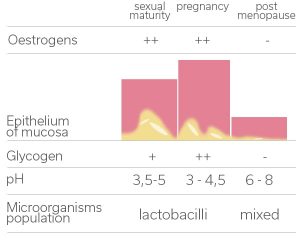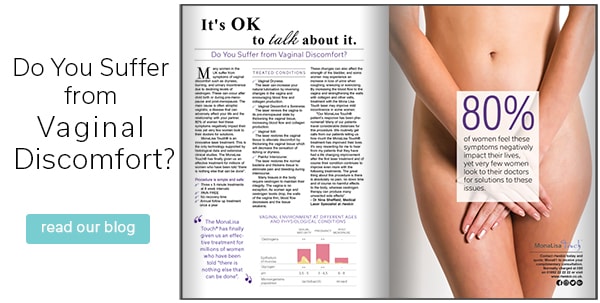MonaLisa Touch® is the new laser treatment against Vaginal Atrophy, Laxity and Urinary Incontinence
Treatment for Vaginal Dryness and Laxity in Tunbridge Wells, Kent and Sussex
 Do you also suffer from vaginal discomforts?
Do you also suffer from vaginal discomforts?
Vaginal discomforts as dryness, burning, urinary incontinence can occur during pre-menopause or after child birth. The main cause is often atrophic vaginitis: a disease that can adversely affects your life and the relationship with your partner.
Now it’s possible to restore vaginal health with no pain, no side effects and in just few minutes.
MonaLisa Touch® is a painless and minimally invasive laser treatment for vaginal rejuvenation. By gently acting on tissue of the vaginal mucosa, the laser stimulates the production of collagen, improving the functionality of the treated area and restoring the proper trophic balance to the mucous membrane.
MonaLisa Touch® laser treatment helps restore vaginal health due to new collagen, elastin and vascularization
The exclusion criteria:
Pregnancy
Urinary infections
Intake of photosensitive drugs
Patients with the II degree prolapse
Injury or/and active infection in the treatment area
Undiagnosed vaginal bleeding, and active menstruation
Patients who have undergone pelvic reconstructive surgery
The inclusion criteria:
Menopausal and Peri-menopausal women who have (or not have) been administered estrogens in the 6 month prior to treatment
Vaginal dryness, irritation or burning pain
Normal cell cytology (PAP smear)
Symptoms and discomfort related to vaginal laxity, with a pelvic organ prolapse I degree
Vaginal canal and vestibule free of injuries and bleeding
Preparing for your procedure
You should maintain a sensible diet. Daily exercise in the run up to the procedure will improve your recovery.
Discuss the operation with your General Practitioner (GP) and get him/her to review your medications. Medications such as low dose aspirin, non-steroidal anti-inflammatories (such as Ibuprofen, Diclofenac) & blood thinning medications need to be stopped at least seven days before the operation.
If you have any symptoms of a cold or flu in the days leading up to the operation you must let us know as this may necessitate cancellation until you are well.
In the two days before the operation take plenty of fluids. It is important to avoid dehydration in the days before treatment.
Before your procedure
It is essential that patients attend a pre-admission clinic, when you will have a consultation and a laser test patch.
At this clinic, we shall ask you for details of your medical history and carry out any necessary clinical examinations and investigation
You must tell us if you are diabetic
Patients who have this type of procedure will not need to stay in hospital but should rest at home or at a hotel close to the clinic for one or two nights – our doctor will discuss this with you before you decide to have the procedure.
After the procedure
After the procedure you will stay in the recovery room until you feel well enough to move.
Re-treatment, check-ups and results: When you are discharged an appointment will be made for you to be seen by the doctor in the clinic 4-5 weeks after your procedure. At this appointment, you will be seen by a member of the team. You will be asked to complete a questionnaire so that we can assess how the operation has helped with your symptoms. You may then be advised to have a second or third treatment.
Eating and drinking: as normal
When you can leave the clinic: Most people who have had this procedure will be able to leave the clinic immediately after. The actual time that you need to rest will depend on your general health, how quickly you recover from the procedure and your doctor’s opinion.
When you can resume normal activities including work: Most people who have had this procedure can resume normal activities the next day. You might need to wait a little longer before resuming more vigorous activity.
Vaginal bleeding. You may have some vaginal bleeding after the procedure. This will gradually decrease over the following few days.
Bowels. It is important to avoid constipation.
Pelvic floor exercises: It is important that you continue with the physiotherapy exercises
Housework. Do not lift anything heavy. This means that you will not be able to do heavy housework for a few days.
Sexual Intercourse. It is safe to resume sexual intercourse after two weeks. It is advisable to use a commercial lubricant for the first time (Vielle, Durex or Sylke).
MonaLisa Touch® allows for a functional restoration of the vagina (Laser Vaginal Rejuvenation), which helps fighting and attenuating symptoms related to vaginal atrophy, a widespread problem among pre and postmenopausal women. Thanks to its action on factors that determine dryness, fragility and loss of mucosal elasticity, this treatment can eliminate troublesome itching, irritation and pain, which become particularly acute during intercourse. The interaction with laser is, in fact, the ideal method to stimulate the collagen contained in the vaginal walls for the rehydration and functional tissue restoration. Its beneficial action can contribute to improve self-confidence and sexual pleasure.
All laser procedures will require a test patch a minimum of 24 hours prior to treatment. This is a standard requirement for safety and insurance purposes.
A swab is inserted into the vagina to dry out the inside as much as possible prior to the insertion of the laser. This is the uncomfortable part of the procedure. The specially designed laser scanner and probe system is then inserted into the vagina. The patient will feel a low grade warm vibration inside the vaginal canal which is virtually painless for most women. This process lasts for around 5 minutes, the probe is then removed and the treatment is complete. In as little as 30 days after the treatment the regeneration of new tissue in the vaginal wall builds a naturally stronger vaginal structure and the protective mucosa recovers lost volume, hydration and elasticity
The procedure is virtually painless and requires no anaesthesia. The sensation is a light warm vibration
A standard MonaLisa Touch® Laser treatment plan consists of a preliminary medical consultation and initial three to four sessions over 8 to 16 weeks plus a “booster treatment” around 12 months. The actual treatment takes less than 15 minute
Most treated patients report a reduction in dryness, burning sensation, pain during intercourse, and urinary symptoms which contributes to a substantial improvement in the quality of life. These results are possible, thanks to the stimulation of the mucosa, which regenerates and rejuvenates
The term “vaginal laxity” refers to a condition where the diameter of the vagina has increased. This is often caused by natural yet traumatic events, such as giving birth or tissue relaxation due to a natural ageing process. In these cases, it is essential to evaluate the cause and the state of the vagina to exclude a prolapse or an involvement of the muscles. The CO2 fractional laser MonaLisa Touch® allows treating those cases where the “loose vagina” is due to a mucosal tone loss
It depends on how serious the symptoms are. We usually recommended 1 to 3 treatments, 40-60 days apart, followed by an annual maintenance treatment. In any case, it will be up to your doctor, after careful examination, to evaluate and recommend the best treatment plan for you
Most women report slight localised discomfort following the laser treatment and during the first few days after the session. Many have reported to have resumed their normal routine after one to three days. During the healing period, it may be recommended to avoid lifting weights or some activities, such as taking a hot bath, or physical exercise. Your doctor will give you specific indications for a speedy recovery. Patient must refrain from vaginal intercourse for 5 days to allow the vaginal canal surface to heal properly
The results are immediate, even after the first treatment and improve over subsequent months. The regeneration process that it triggers lasts 40-60 days, after which it is advisable to repeat the treatment


